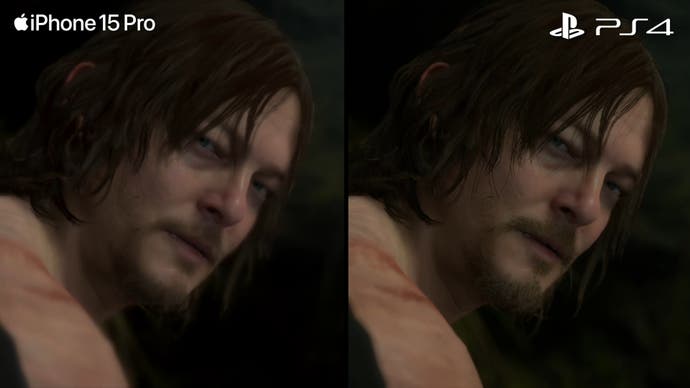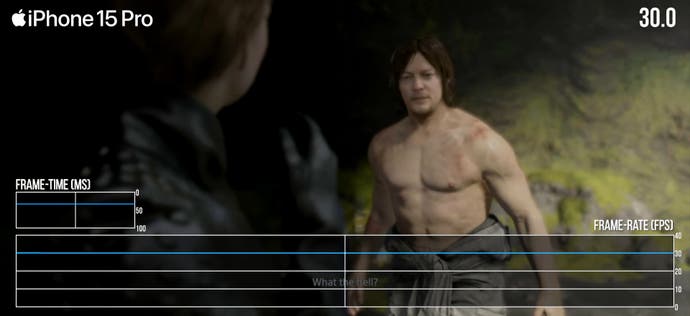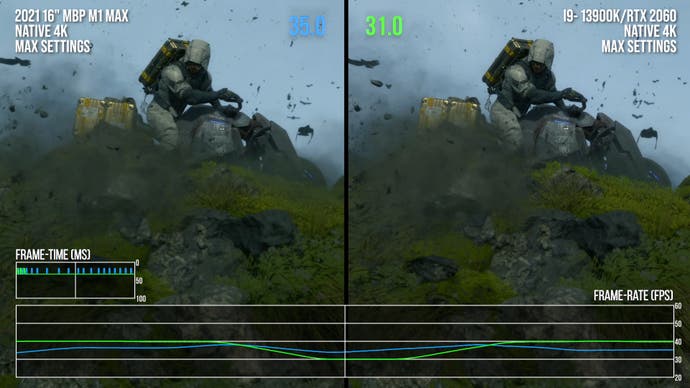Death Stranding's iOS and MacOS ports are a mixed bag
Impressive on Mac, but iPhone 15 Pro struggles.
In parallel with development of a stunning-looking sequel, Kojima Productions has continued to work on the original Death Stranding, delivering a series of ports - and the latest is exceptionally intriguing, targeting MacOS and selected iOS devices. A single purchase gets you access to a game that runs on Apple Silicon Macs and iPads - as well as the iPhone 15 Pro. The promise is mouthwatering, especially on iOS: the full Death Stranding experience on portable, fanless devices.
Cutting to the chase, Apple's iPhone 15 Pro comes surprisingly close to the console experience in Death Stranding. The basic visual setup is convincing, with visual settings not too far from its PS4 counterpart. Pausing on the opening shot of gameplay, there are some differences - the rain is less prominent on iPhone, the foliage looks different in spots, and some LODs have been trimmed back, but it's otherwise a very comparable looking shot. Near-field detail is about the same between iPhone and PS4, while more distant LODs are sometimes simplified. Foliage density and quality has also been tweaked. There are obvious differences in image clarity as well, though we'll touch on that in a few moments.
Even shadow resolution - which is typically the first port of call to cut back on mobile ports - is about the same between the two systems. Screen-space reflections are maintained on iPhone, though they do look a bit coarse. Decima's volumetric cloud system does get a pretty sizeable haircut on iPhone, with chunkier and more artifact-ridden volumes. I imagine the Nubis clouds are running at a substantially lower resolution, with passable enough but somewhat noisy results.
Cutscenes are handled in a couple of ways with iPhone 15 Pro's 19.5:1 aspect ratio. Typically, this means extra content on the left and right hand side of the screen during gameplay, relative to the PS4 release. However, quite a few of the cutscenes, including large parts of the opening sequence, display a cropped image instead. Some of these shots are pre-rendered videos, and others may not have been designed for an expanded field of view and the content beyond the frame might not be appropriate for player view. I would say a majority of the cutscene content is still presented without cropping, but some shots are indeed punched in, though I didn't find it distracting.
Post-processing niceties like depth of field and motion blur are preserved here, which keeps the cinematics appropriately film-like. At times, the depth of field did appear somewhat shallower on iPhone, again likely a consequence of resolution differences. Relative to prior iPhone efforts that I've looked at, Death Stranding manages to preserve a surprising amount of the visuals from its PS4 forebear. There are some little nips and tucks, but not many significant consistent deficits, at least judged from what I can make out.
iPhone users pay for those features by taking a hit in rendering resolution. The iPhone 15 Pro appears to use a dynamic resolution in the game and it seems to average around 400p in typical play. The game has motion blur that can't be turned off, so I wasn't able to sample anything like an exhaustive range of resolution counts, but around 400p seemed to be the average, with the game shifting to higher or lower pixel counts depending on load.
Relative to the 1080p PS4 release, obviously image clarity takes a huge hit and there's a lot of additional breakup in the image as well. However, on a small mobile display of a high quality, it's not as bad as those top-line numbers would indicate. We don't have any MetalFX upscaling to provide better image clarity unfortunately, unlike Resident Evil 4 for instance which looked reasonably sharp despite running at around 300p internally.
Performance-wise, Death Stranding targets a 30fps update, without any visual modes to change or visual selections of any kind. More often than not, we are at or around that 30fps line, but the game does exhibit severe issues at times. Around artificial structures, there are heavy frame-rate dips, with the game falling to some pretty deep lows with heavy stuttering. During more intense action moments, the game suffers from severe performance lows too. General traversal is also hit with occasional stuttering, and some cutscenes also have issues. The game also seems to have some frame-pacing issues as well, but these seemed more severe in my video output capture than on the system itself. Even on the device though, you can observe frame-time inconsistencies during basic traversal.
Thankfully, Death Stranding is pretty easy to set up with an external gamepad, supporting both PlayStation button icons and Xbox icons depending on what you have connected. Unfortunately, the touchscreen controls are fairly awful, with each regular controller button represented. I like games that try to carefully consolidate functionality to context-aware software buttons, like Call of Duty Mobile or the Grand Theft Auto games, but that isn't the approach taken here. I really can't recommend playing this title at all unless you're planning to play with a physical gamepad.




Death Stranding holds up visually on iPhone 15 Pro then, with the biggest issue coming from uneven performance - but the game runs on MacOS too, where many extra options and features are open to players. I think the most interesting place to start is by looking at Apple's MetalFX upscalers. In performance, these provide a definite win. In the more difficult sections of the opening cutscene, there's up to a 2x performance boost over native resolution rendering by using Apple's MetalFX temporal upscaler, which operates from an internal resolution of 1080p.
If we drop down to the medium settings preset, we can squeeze a little bit more performance out of our system, but it seems like the MetalFX temporal technique - which is an AI upscaling technology like DLSS - is really helping out with those frame-times. It's the same in gameplay, boosting 36fps at native 4K to a vsync-limited flat 60fps with MetalFX temporal in performance mode. Image quality results are quite positive as well. Death Stranding has a limited form of TAA that doesn't give images a very thorough edge treatment. At native 4K, obtrusive edge aliasing is an issue, almost appearing as if there's no AA at all. MetalFX temporal is substantially less aliased, even when operating from one-quarter the internal resolution.
At rest, the MetalFX image does have some additional blur, although the anti-aliasing treatment is generally quite a bit better. I like the precise look of the native 4K image, but image stability is probably more important, especially if you are playing on a large format display. Overall, I'd definitely prefer the look of the MetalFX-treated image, and of course the extra performance helps a lot as well. MetalFX Spatial is here too, but it's best avoided. It essentially looks like a much lower-res image, just sharpened and given an FSR 1-style image upscale. In stills it can look passable, but in motion things do fall apart somewhat.


With these results in mind, I decided to play the first couple hours of the game with medium settings with screen-space reflections and motion blur enabled, at 4K with MetalFX temporal in performance mode. The differences between max settings and medium settings aren't especially profound, and I wanted to make sure we hit as close to 60fps as possible. Using my 16-inch MacBook Pro with M1 Max, I was locked to 60fps for the vast majority of the time. Overall, the performance feels very smooth. I did note some dips from time to time during traversal, though these tended to be quite minor. Cutscenes can have some dips as well, with the worst coming in the classic DF Death Stranding stress test which uses a high-quality planar reflection. I also saw some minor issues when in contact with the BTs, albeit in a more intense scenario not indicative of general play.
Overall, the performance figures are very solid, especially relative to what we saw on iPhone. It's not a locked 60 with these settings, but it does come close, and the visuals look excellent. This is certainly a better experience than I recall having back in the day on my PS4 Pro, pushing a 60fps frame-rate target with great-looking visuals. My 16 inch 2021 MacBook Pro is a fairly high-end Mac, but newer M2 and M3 based Macs can be significantly faster, so they should produce even better results.
Bringing in the PC code and comparing it to the M1 Max at the highest settings at 4K, There's a very similar alignment between the performance of an RTX 2060 desktop based system and the M1 Max, with closely matched frame-rates. The RTX 2060 is ahead more of the time than the Max, but the two systems deliver a very similar experience. That's a perfectly respectable result for the laptop chip, and falls roughly in line with its typical relative PC performance in well-optimised games and benchmarks. Interestingly, the RTX 2060 runs the opening cutscene more consistently at 60fps with DLSS than the M1 Max with MetalFX, suggesting that the MetalFX temporal upscaler may be computationally heavier than DLSS.

Summing up, Death Stranding on iPhone produces mixed results. It does retain most of the basic visual settings that make the console version of the game look so good, but it suffers from relatively low-res rendering and has some definite frame-rate problems. Like other prominent iPhone games we've seen recently, it delivers roughly PS4-class visuals, just with resolution compromises and FPS annoyances.
After reviewing quite a few titles, the iPhone 15 Pro appears to sit somewhere between seventh and eighth gen home consoles in hardware capability for modern games. We're well short of parity with a PS4 or Xbox One, but the system can achieve very impressive visuals within a mobile form factor, especially when viewed on the relatively small iPhone display. The primary issue in the iPhone titles I've reviewed to date is inconsistent performance, with most high-end games struggling to achieve a smooth frame-rate readout.
For me at least, Death Stranding is an interesting novelty on the phone - and an impressive little tech demo - but I'd rather play the game on a home console or computer. On Mac, though, it's a different story. I was able to run the game at a relatively consistent 60fps at 4K output using MetalFX, producing an attractive and smooth experience. I can't speak to all M-series devices here, but the Apple Silicon Mac port seems to be in quite good shape and it runs quite nicely. At its core, Death Stranding is still a last-gen title, but it looks beautiful and runs quite well even on a relatively thin and efficient laptop system. We'll see how future high-end Apple ports turn out, but until then this is a slightly mixed outcome, the quality of the experience varying significantly depending on the device you're playing on.
















